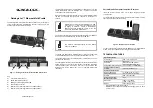
PILOT’S
GUIDE
63
STRIKE FINDER
DIGITAL WEATHER AVOIDANCE
The pilot is seldom aware of what happened. When communications are
reestablished, ATC may assume the pilot was not paying attention to his
radio.
Solutions to corona noise include antennas that are insulated from space
and static discharges positioned where the aircraft is most likely to go into
corona; wing tips, vertical and horizontal stabilizers are examples. Static
discharges bleed off charge quietly.They lower aircraft voltage below a level
where antennas go into corona.
Arcing Noise
This interference is generated by an isolated piece of metal situated on an
aircraft where, as the aircraft charges, it reaches a potential at which a spark
jumps the gap from aircraft structure to isolated metal. The spark can
produce broad band noise extending through 1,000 MHz. The cure is to
locate the isolated metal and bond it to the aircraft structure grounding strap.
To locate this problem, the aircraft can be probed with an
Electrostatic Test
Set
while monitoring aircraft receivers for arcing noise.When the noise area
is identified, physical identification can isolate the piece of metal.These and
other solutions can greatly lessen the effect of environmentally induced
noise while in flight.
During WWII it was necessary to have navigation and communication
systems that were reliable in all weather conditions. To address the
interference problem the Naval Air Development Center (NADC) sponsored
a program to develop methods to reduce noise created by
P-Static.
As a
result of this program, Dayton-Granger invented and patented the first static
dischargers.
Continued research and development in the 1950’s led a static discharger
which adopted a new concept that was far superior in noise suppression
than anything else.This patented device, designed the Granger Associated
(later to be a part of Dayton-Granger) was the Nullified Discharger which
is still the industry standard today.
Strike Finder Pilot's Guide fix 9/19/05 10:59 AM Page BP



































